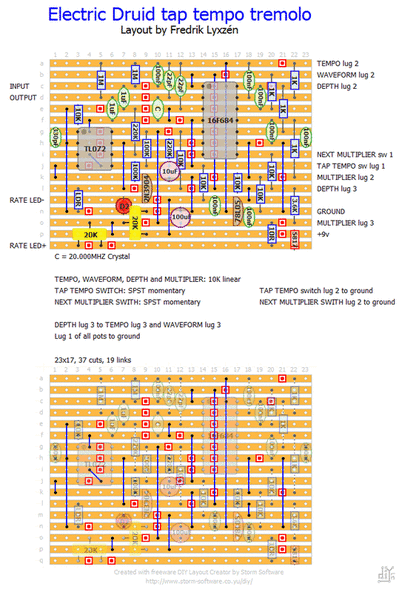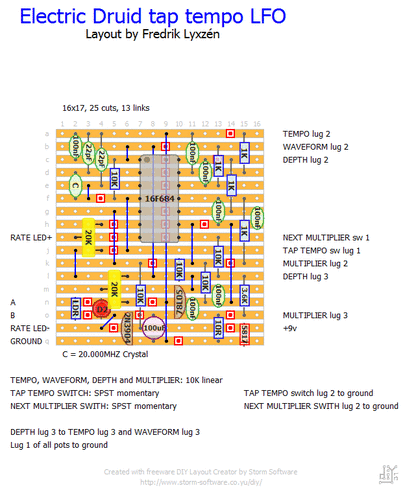|
This is a very cool and versatile tremolo by Electric Druid. The signal path is taken from the Tremulus Lune, but the LFO is replaced with a digital chip with tons of features: Tap Tempo, 8 different waveshapes (even a random shape!) and a multiplier function. If you are new to digital chips that require code, read more in my Guitar to MIDI post. Have a look at my finished build here. Read more about this project and download the HEX code or buy the PCB/pre-programmed chip-kit here: http://www.electricdruid.net/index.php?page=projects.taplfo I also drew up this layout with only the LFO, Figured it might come in handy. For example to modulate the speed of a delay to create some pitchbend/chorusy effects... Hmmm, wonder how that random waveshape will sound. :o) I have not built this one yet, but it should be ok. Hook up A and B to any pot you want to modulate/replace. Use a regular LED and wrap it in heatshrink or tape with the LDR or use a vactrol. I used a VTL5C3 vactrol in my build.
10 Comments
Jordan
10/30/2016 03:01:37 pm
There seems to be a big volume drop when the tap tempo is on would you know which resistor to change to bring the volume up
Reply
11/9/2016 07:21:08 am
Hi Jordan,
Reply
Matt Roberts
4/10/2017 05:22:20 pm
Hi! I hope this doesn't sound stupid but I'm looking at this layout and your build pic and wondering exactly how veros are done. Your build looks upside down and back to front from the vero? What am I missing?
Reply
4/12/2017 04:01:45 am
Hi Matt
Reply
Matt Roberts
4/16/2017 08:48:11 pm
Hi Fredrik.
Matt Roberts
4/17/2017 03:30:30 am
Also, can you tell me what the 20K yellow, 3 legged components are?
Matt Roberts
4/17/2017 05:21:31 pm
Ah I see now they're trimpots! 😊
Reply
Anthony
5/6/2017 11:05:36 pm
Thanks for the layout, Fredrik! Did you ever hook this up to a PT2399?
Reply
5/15/2017 01:09:13 am
Hi Anthony,
Reply
Facundo Malacalza
7/19/2017 11:37:51 am
Hi men,
Reply
Leave a Reply. |
vero layoutsAll the layouts are Verified unless noted. Archives
February 2018
Categories
All
|


 RSS Feed
RSS Feed